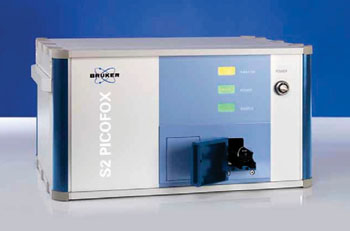Low Selenium Levels Linked to Liver Cancer Development
By LabMedica International staff writers
Posted on 21 Jul 2016
Selenium is a trace mineral micronutrient that is found in foods like shellfish, salmon, Brazil nuts, meat, eggs, grains, and onions. However, selenium levels in foods depend largely on the levels of selenium in the soil where the food is grown and animals graze.Posted on 21 Jul 2016
The highest levels of blood selenium or of selenoprotein P, the protein that distributes selenium from the liver around the body, are associated with a decreased risk of developing liver cancer, particularly hepatocellular carcinoma, even when all other major liver cancer risk factors are taken into account.

Image: The benchtop Picofox S2 total reflection X-ray fluorescence spectrometer (Photo courtesy of Bruker Nano).
A sizeable group of international scientists associated with the International Agency for Research on Cancer (Lyon, France) carried out a study that was based on the European Prospective Investigation into Cancer and Nutrition (EPIC) cohort, which is composed of more than half a million participants across 10 European countries, using a case-control design of 121 liver cancers and 140 gall bladder and biliary tract cancers matched to equal numbers of individuals free of cancer within the cohort.
Concentrations of total selenium were measured by X-ray fluorescence and analyzed by using a bench-top Picofox S2 total reflection X-ray fluorescence spectrometer (Bruker Nano GmbH, Berlin, Germany). A colorimetric enzyme-linked immunosorbent assay (ELISA), the Selenotest, was used to measure selenoprotein P (SePP) concentrations (ICI GmbH, Berlin, Germany). The samples were measured in duplicate and mean concentration values, standard deviation, and coefficient of variation (CVs) were calculated.
The scientists found that hepatocellular carcinoma (HCC) and gallbladder and biliary tract cancer (GBTC) cases, but not intrahepatic bile duct cancer (IHBC) cases, showed significantly lower circulating selenium and SePP concentrations than their matched controls. Higher circulating selenium was associated with a significantly lower HCC risk (Odds Ratio (OR) per 20g/L increase: 0.41) but not with the risk of GBTC or IHBC. Similarly, higher SePP concentrations were associated with lowered CC risk only in both the categorical and continuous analyses (HCC: OR per 1.5-mg/L increase: 0.37).
The authors concluded that their findings from a large prospective cohort provided evidence that suboptimal selenium status in Europeans may be associated with an appreciably increased risk of HCC development. Randomized controlled trials in populations in which selenium status is suboptimal (e.g., Western Europe) are needed to test whether increasing selenium intake may reduce the risk of hepatobiliary cancers, especially for those at high risk (e.g., Hepatitis B or C positive) for HCC and GBTC. The study was published on June 29, 2016, in The American Journal of Clinical Nutrition.
Related Links:
International Agency for Research on Cancer
Bruker Nano
ICI




 assay.jpg)









